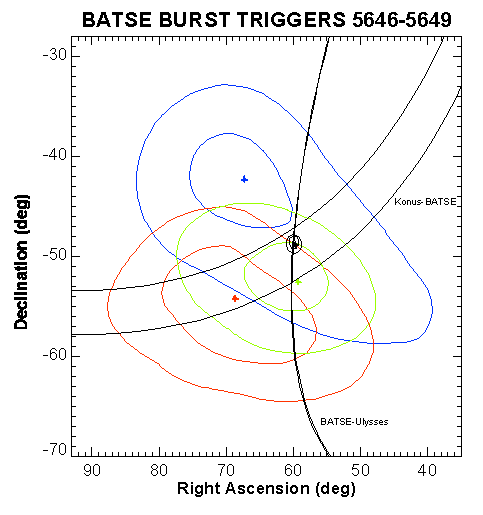2 min read
What am I seeing?

There are computations for each burst based on BATSE data alone, shown as the red, green, blue, and black concentric figures, as well as a location area determined from interplanetary triangulation of the brightest event between BATSE and the Ulysses spacecraft (the thin narrow arc running vertically labelled BATSE-Ulysses), and a similar triangulation between BATSE and Konus (the thick region running from the upper right of the diagram to the left).
Astronomers cannot be certain of the precise location of these events, because gamma-ray burst experiments cannot take "pictures" of the sky as we might normally think of them.
So, instead of a particular precise coordinate, scientists use what are called "confidence regions" or "error-boxes." These allow scientists to say "We're pretty sure the event came from somewhere in this box." The "position"of the source is then determined by finding where each of the boxes overlap one another.
For each of the four BATSE bursts, two confidence regions are shown, along with a cross (+) indicating the most likely position of the event as computed from the BATSE data. The larger concentric shape provides a higher degree of confidence that it contains the true burst position, at the cost of includingmuch more area in the sky. To give you an idea of just how imprecise the burst locations can be, the diameter of the black circles near the center of the plot are about three times the diameter of the full moon.
Nevertheless, the confidence regions for each of the four bursts overlap, and are consistent with the narrow arcs obtained from triangulation. The BATSE-computed position for the brightest of the four events, shown as the concentric black circles, offers excellent agreement with the intersection of the BATSE-Ulysses arc and the Konus-BATSE arc.
These agreements lead astronomers to believe that the four bursts are likely to have come from the same spot in the sky.
return to top of page -or-
Back to BATSE headline
Author: Dr. John Horack
Curator: Bryan Walls
NASA Official: John M. Horack







